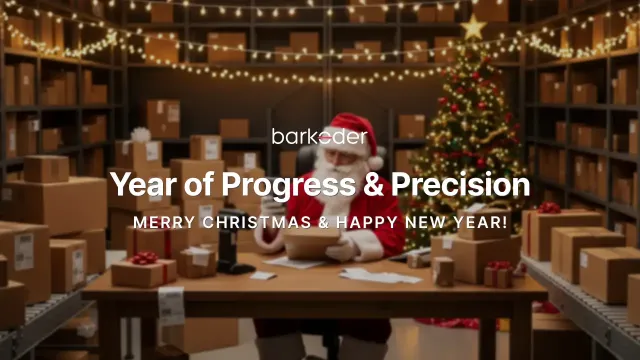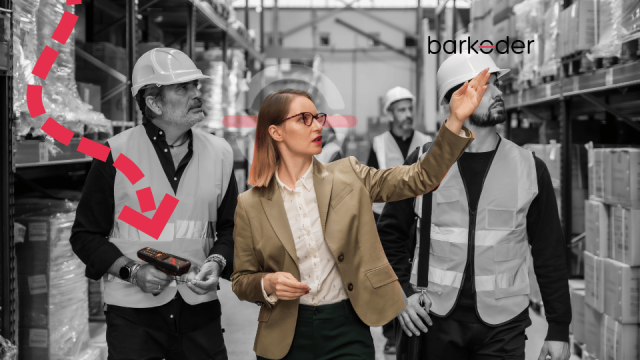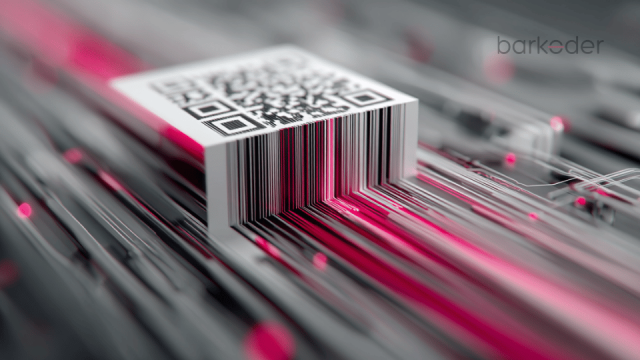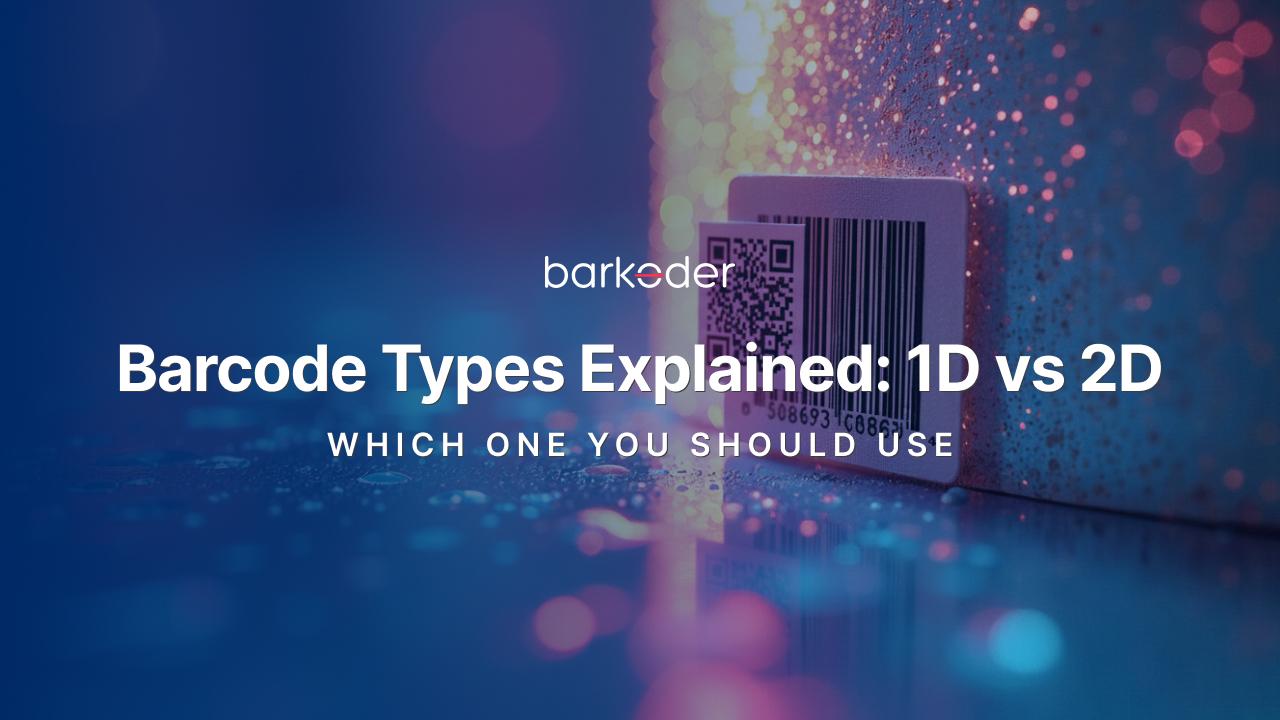
Barcode Types Explained: 1D vs 2D and Which One You Should Use
The short answer first
If you need a one line takeaway:
- Retail point of sale usually equals EAN or UPC for today and an approved GS1 two dimensional code by the end of 2027 as systems upgrade.
- Logistics and distribution labels usually equal GS1‑128 and sometimes ITF‑14 for corrugated cases.
- Regulated healthcare packaging in the United States usually equals GS1 DataMatrix on each saleable unit under DSCSA.
- Direct part marking on metal or plastic items in defense and aerospace usually equals Data Matrix ECC 200 with DPM verification rules.
- Driver licenses in the United States and Canada carry a PDF417 that is mandatory in the current AAMVA card design standard.
- Airline boarding passes follow IATA BCBP which uses PDF417 for printed passes and Aztec or Data Matrix or QR on mobile.
- Post and mail streams in the United States use the USPS Intelligent Mail barcode for letters and are adding a USPS DataMatrix code called IMmb on packages.
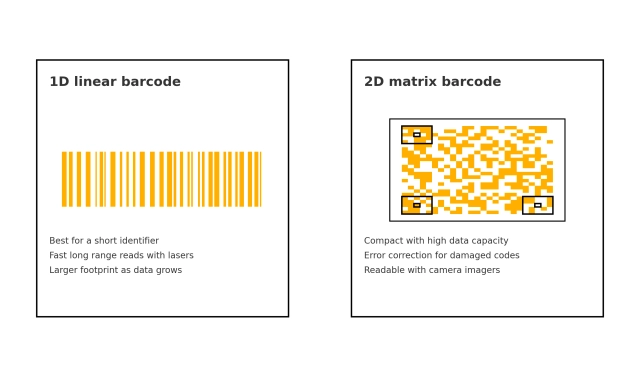
What each symbology family actually offers
One dimensional codes you will meet most often
UPC and EAN
The global retail baseline for point of sale. GS1 guidance says this is the symbol that retail scanners read everywhere today and it remains the default while stores transition to two dimensional options. barKoder has become a verified GS1 partner for both US and Germany.
GS1‑128
A structured version of Code 128 that carries GS1 Application Identifiers for dates, batch numbers and serial numbers. It is the backbone of GS1 logistic labels and is widely used across transport and warehousing.
ITF‑14
Optimized for printing directly on corrugated outer cases and restricted to trade items not scanned at retail point of sale.
Code 39
Historically important in United States defense logistics through LOGMARS and MIL standards. Newer Department of Defense guidance recommends two dimensional symbols such as PDF417 for many packaging marks but Code 39 remains part of older specifications and niche processes. Code 39 is widely used in the automotive industry for encoding Vehicle Identification Numbers (VINs). It's a versatile alphanumeric barcode format that can represent numbers, uppercase letters, and special characters, making it suitable for identifying and tracking vehicles throughout their lifecycle.
USPS Intelligent Mail barcode
A four state linear code used to sort and track letters and flats with one symbol that embeds multiple service options.

Why choose one dimensional
They remain easy to print at high speed and can be read by inexpensive laser scanners. They are ideal when you only need an identifier and a small set of characters with long standoff distances in conveyor environments. GS1 highlights one dimensional symbols for logistics flow where a single identifier is enough and when you print on corrugate. GS1
Two dimensional codes you will meet most often
QR Code
High capacity with standardized error correction. DENSO WAVE notes up to 30 percent of the code area can be damaged and still decode at the highest correction level and cites a maximum of 7,089 numeric characters for Model 2 at the largest version.
barKoder’s own SDK can detect even if 70 percent of the barcode is missing as shown https://barkoder.com/barcode-scanner-sdk/matrixsight
Data Matrix and GS1 DataMatrix
Very compact at small sizes and robust on curved or challenging surfaces. United States DSCSA requires a two dimensional Data Matrix on each saleable unit package for human drug products.
PDF417
A stacked linear code well suited to identity documents and transport documents. AAMVA makes PDF417 the minimum mandatory machine readable technology on driver licenses and ID cards in North America.
Aztec
Designed for fast, reliable decoding with a central finder pattern. IATA BCBP allows PDF417 for printed boarding passes and Aztec or Data Matrix or QR for mobile boarding passes.
USPS IMmb
IMmb (Intelligent Mail Matrix Barcode) is a GS1 DataMatrix-based symbol developed by the United States Postal Service (USPS) for use on package labels. It provides a smaller footprint and redundant reads alongside the existing IMpb, improving sortation reliability on automated equipment.
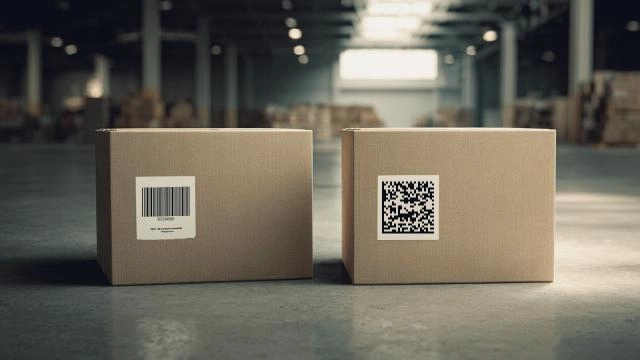
Why choose two dimensional
You get far more data in less space, built in error correction, and compatibility with modern camera imagers including smartphones. This is why healthcare, identity, aviation and retail engagement use two dimensional carriers. GS1 and regulators are aligning on two dimensional carriers where richer data at the scan point is useful.
Where each type is used and why
Retail point of sale
Today
EAN and UPC remain the global default for consumer items. GS1 guidance calls them the symbol that scanners read worldwide.
What is changing
The industry goal known as Ambition 2027 is that every retail point of sale can read and process approved GS1 two dimensional barcodes in addition to linear symbols. GS1 has issued implementation guidance and test suites for this transition. The change is driven by needs such as traceability, safety information and digital engagement.
Why some two dimensional codes were not used until now
Large installed bases of laser scanners could only read one dimensional codes. Zebra confirms laser engines read one dimensional codes while area imagers read both one and two dimensional codes. That hardware reality is the core reason retail needed time to upgrade.
Transport and logistics
- GS1‑128 on logistic labels to carry identifiers and attributes such as SSCC, dates and batch numbers. ITF‑14 when printing a GTIN directly on corrugated outer cases. These choices exist because they are durable on high speed lines, widely read by fixed scanners and fit GS1 logistics label guidance.
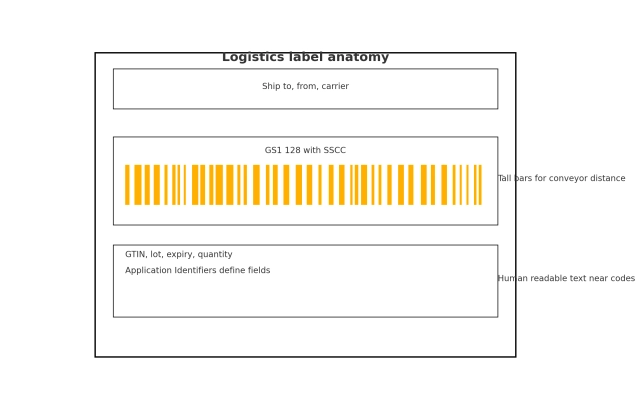
Healthcare and pharmaceuticals in the United States
- GS1 DataMatrix on each saleable unit under DSCSA. FDA guidance states packages must be marked with a two dimensional Data Matrix that encodes the product identifier elements and that QR Codes cannot replace the required two dimensional Data Matrix on packages. U.S. Food and Drug Administration
Why not Code 128 on the smallest packages
Linear codes expand in one direction and run out of label real estate. Data Matrix fits long identifiers plus date and lot in a very small footprint and still meets verification rules. FDA communications and pilots emphasize the growth in properly encoded two dimensional Data Matrix symbols as DSCSA rolls out.
Direct part marking for durable assets
- Data Matrix ECC 200 on metal and plastic parts for defense and aerospace with item unique identification. MIL‑STD‑130 requires permanent machine readable marks and the DoD IUID program encodes the unique item identifier in a Data Matrix symbol. Verification uses ISO or AIM DPM methods because direct marks behave differently than printed labels.
Why not one dimensional
You need compact marks, damage tolerance and reliable reads on curved or blasted surfaces where one dimensional codes would be too large or fragile. ISO 29158 describes DPM quality methods that adjust the ISO 15415 print quality approach for this environment.
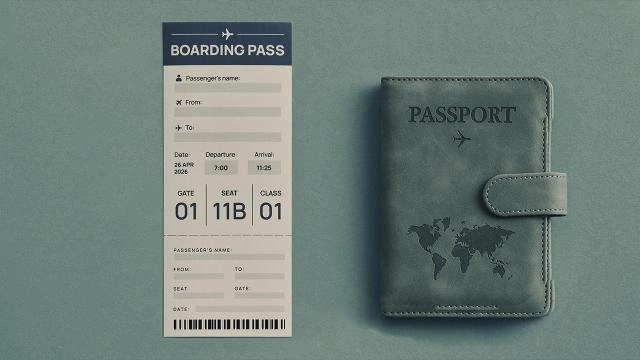
Government ID and travel
- Driver licenses and ID cards use PDF417 as the mandatory machine readable technology in the 2025 AAMVA standard because it carries many fields reliably and can be verified consistently by law enforcement. AAMVA
- Airline boarding passes use IATA BCBP which defines symbologies and data formats for printed and mobile boarding passes. PDF417 is used on paper boarding passes. Aztec, Data Matrix or QR are used on mobile. The design balances speed through checkpoints and robustness under different lighting conditions.
Postal and parcel
- Letters and flats use USPS Intelligent Mail barcode which combines routing and service data.
- Packages are gaining an additional USPS Intelligent Mail Matrix Barcode which uses GS1 DataMatrix for a smaller footprint and redundant reads alongside existing IMpb. This improves sortation reliability on automated equipment.
Payments and consumer engagement
- QR Code payments are standardized by EMVCo which publishes specifications for merchant presented and consumer presented QR payments. This is why QR dominates in pay by scan experiences.
Security caution
Law enforcement has issued public warnings about malicious QR codes used for fraud. If you use open QR for consumer links, adopt controls such as domain allow lists and tamper resistant label placement.

Why some codes are rarely used in certain places
Scanner compatibility
Legacy laser scanners only read one dimensional codes. Area imagers read both. The upgrade path from laser to imager has driven the timing of two dimensional adoption in stores.
Regulatory and industry rules
Some sectors mandate a carrier. AAMVA mandates PDF417 on driver licenses. IATA BCBP defines the allowed boarding pass symbologies. DSCSA requires two dimensional Data Matrix on packages. You choose what the rule says.
Physical constraints
Linear codes grow with content. That makes them hard to fit on very small packs and curved items. Data Matrix and QR keep size down while holding more data and provide error correction. FDA and GS1 resources discuss the need for small, high quality two dimensional symbols on healthcare units.
Operational constraints
Long range conveyor scanning favors tall, high contrast one dimensional symbols that omnidirectional laser tunnels or raster lasers can hit at speed. Logistics guidance from GS1 keeps GS1‑128 and ITF‑14 in that world.
Security and misuse
Open QR destinations can be tampered with in public spaces. Use printed controls or protected locations and verify domains. The FBI has warned about QR scams that redirect to phishing or fraudulent payment portals.
Implementation notes that save rework
Use the right quality standard
Verify print quality for linear codes with ISO 15416 and for two dimensional codes with ISO 15415. For direct part marks use ISO or AIM DPM verification as described in ISO 29158. These are the references used by verifiers and by application standards such as MIL‑STD‑130.
Follow GS1 syntax when you need structured data
GS1‑128, GS1 DataMatrix and GS1 QR use Application Identifiers to encode dates, lots, serials and more. This is expected on GS1 logistic labels and in DSCSA contexts that use GS1.
Retail two dimensional migration is a program not a symbol
GS1 has a detailed point of sale implementation guideline and a test suite. Brands and retailers should plan dual marking phases and staff training before going single two dimensional on selected assortments.
Concrete scenarios and what to pick
Small prescription vial in the United States
Use GS1 DataMatrix with GTIN, serial, lot and expiry to meet DSCSA. QR does not satisfy the DSCSA package requirement.
Corrugated shipper that never passes retail point of sale
Use ITF‑14 with the GTIN or use GS1‑128 when you need SSCC and other Application Identifiers on a GS1 logistic label.
Warehouse pallet label with track and trace
Use GS1‑128 with an SSCC on the GS1 logistic label. This is conventional and inter‑operable.
Machine part that will live twenty years on an aircraft
Mark a permanent Data Matrix ECC 200 and verify it with ISO 29158 methods per MIL‑STD‑130 and related IUID guidance.
State driver license
Use the AAMVA mapping which makes PDF417 the required machine readable carrier.
Printed airline boarding pass and mobile boarding pass
Use PDF417 on the printed boarding pass and Aztec or Data Matrix or QR for mobile as allowed by IATA BCBP.
Letter mail in the United States
Use USPS Intelligent Mail barcode to participate in USPS programs and tracking.
Package label inside the USPS network
Add USPS IMmb DataMatrix in addition to IMpb to improve read reliability and redundancy.
In store consumer engagement on a food item
Use a GS1 compliant QR or GS1 DataMatrix following GS1 two dimensional in retail guidance and plan for Ambition 2027 scanner readiness.
Comparison by decision factor
Data capacity
Linear codes usually carry a short identifier. QR and Data Matrix carry long fields and multiple attributes which matters for serialization and regulatory data.
Damage tolerance
QR and Data Matrix include error correction. QR has selectable levels up to about thirty percent recovery. Data Matrix ECC 200 uses Reed‑Solomon based redundancy and DPM verification methods adapt to difficult surfaces.
Equipment
Laser scanners read one dimensional codes. Area imagers read both one and two dimensional codes and can read barcodes from displays. This difference drives upgrade planning.
Standards acceptance
Many communities publish exactly what you must print and how to verify it. Examples include AAMVA for driver IDs, IATA for boarding passes, GS1 for retail and logistics, FDA for DSCSA, and DoD for IUID. Choose the code that those documents require.
What this means when you are choosing
Start with obligations
Do you sell into retail, healthcare, defense, aviation or post. If yes, read the sector rule first since it usually fixes the carrier, the data syntax and the verification method.
Then consider the environment
Conveyor speed, read distance, printing method and surface finish decide whether a tall linear symbol or a compact two dimensional mark will be most reliable. GS1 and ISO verification documents exist for both worlds.
Finally plan your migration
If you want consumer experiences with one scan, plan dual marking and the GS1 Digital Link approach on QR or Data Matrix. Align with Ambition 2027 so that retail checkouts can decode your two dimensional data at the same time.
Executive takeaways for U.S. businesses
- Retail checkout in the U.S. is moving toward 2D on packs. GS1 calls this the Sunrise 2027 transition, which prepares retailers and brands to accept and print 2D symbols that can also carry a GTIN for checkout and rich data for traceability and consumer engagement. Early U.S. pilots and retailer discussions are already public.
- Healthcare already depends on 2D. FDA’s DSCSA requires a product identifier in a 2D Data Matrix on prescription drug packages. That choice is driven by size, robustness, and error correction.
- Government ID and aviation rely on PDF417, which packs lots of structured data on a durable card or pass and works without a network. AAMVA’s 2025 design standard makes PDF417 the mandatory machine readable technology on U.S. driver licenses, and IATA’s BCBP uses PDF417 for printed boarding passes.
- Parcel operations are blending 1D and 2D. USPS is adding a two dimensional Data Matrix called IMmb to shipping labels alongside the linear IMpb to improve read rates on creased or irregular packages.
- Classic 1D still dominates cases and pallets. ITF‑14 and GS1 128 remain the workhorses for corrugated and logistics labels since they print well on rough stock and encode shipping attributes with GS1 Application Identifiers.
Side‑by‑side comparison: format, fit, and U.S. examples
| Symbology | 1D or 2D | What it does best | Why it wins here | Why it is not used elsewhere | Typical U.S. examples |
|---|---|---|---|---|---|
| UPC‑A / EAN‑13 | 1D | Fast retail price lookups with a GTIN | Ubiquity at checkout and huge installed base | Limited data capacity and no error correction | Every U.S. retail POS today; will coexist with 2D during Sunrise 2027 transition. GS1 US |
| ITF‑14 | 1D | Identifying cases and cartons printed on corrugate | Wide bars and bearer box tolerate flexo on cardboard | Not for consumer POS or small items | Outer cases in grocery and consumer goods distribution centers. |
| GS1 128 (formerly UCC‑128) | 1D | Encodes GTIN plus attributes like lot, date, weight using GS1 AIs | Logistics label standard and compatible with SSCC | Larger label space and line of sight scanning only | Case and pallet labels with SSCC on GS1 logistic labels and ASNs. |
| GS1 DataBar Expanded (stacked) | 1D stacked | Compact 1D that carries offer data and GTIN | Runs on many legacy laser scanners at POS | Less consumer facing and little room for marketing links | Manufacturer coupons in the U.S. use this format. |
| Code 39 | 1D | Simple alphanumeric, low cost to print | Legacy in defense logistics via LOGMARS | Low density, often replaced by higher capacity codes | Historic DoD logistics labels; largely supplanted on items by Data Matrix IUID. |
| QR Code | 2D | Consumer engagement and payments; high capacity up to 7,089 numerals | Readable by phones and imagers; strong error correction | Not a DSCSA drug identifier on packages; past POS lasers could not read it | Menus, loyalty, packaging engagement, and payment QR per EMVCo. |
| Data Matrix (ECC 200) | 2D | Very compact symbol with robust error correction; good for tiny parts and DPM | Best for small footprints and industrial marking | Not ideal for rough corrugate print at distance | Prescription drug packages under DSCSA; DoD item unique identification; USPS IMmb on parcels. |
| PDF417 | 2D stacked | Large data payload for credentials | Durable on cards and tickets; offline verification | Too large for many retail packs | Mandatory on U.S. driver licenses; used on printed airline boarding passes. |
| Aztec | 2D | Fast decode with small quiet zone; good for mobile screens | Works well for tickets and transport | Less common in retail and logistics | Accepted for mobile boarding passes per IATA BCBP; common in transport tickets. |
Why older 1D lasers slowed 2D adoption at POS
Legacy laser scanners read only one line across a barcode and can read 1D but not 2D. Area imagers capture an image and decode both 1D and 2D, which is why Sunrise 2027 planning often includes scanner upgrades. Vendors confirm lasers are limited to 1D while imagers handle both.
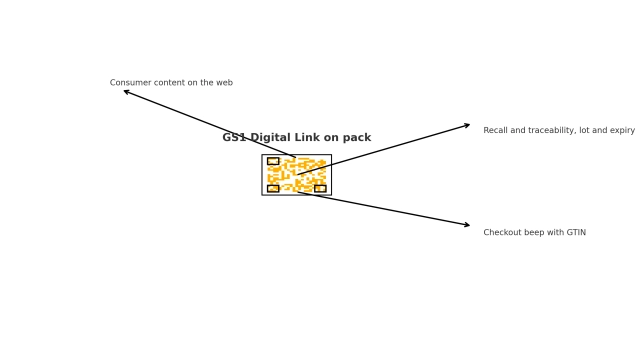
Real U.S. case studies and what to copy from them
1) U.S. retail checkout: preparing for Sunrise 2027
What happened: GS1 US set the industry objective that retailers can scan next‑gen 2D at checkout by the end of 2027. U.S. grocers and CPGs have been piloting 2D on pack, and Wegmans has been a visible voice showing how 2D supports real time product details and food traceability while still scanning at POS.
Why it matters: A single 2D symbol can carry the GTIN for price lookup plus batch, date, and a GS1 Digital Link for consumer content, which means fewer symbols on pack and better recall and waste management workflows.
What to copy: Plan a staged migration: dual mark select SKUs, upgrade a subset of lanes to imagers, and test your content resolution strategy for consumer scans.
2) Healthcare and life sciences: DSCSA product identifiers
What happened: Each package needs a 2D Data Matrix with product identifier elements. Wholesalers and dispensers use those data for verification and traceability.
Why Data Matrix: Very compact symbol fits small vials and cartons, with error correction that survives abrasion and print noise.
What to copy: Align your label generators to encode NDC within GTIN, lot, serial, and expiry in GS1 syntax, and set up ISO/IEC 15415 verification for print quality.
3) Identity and access: state driver licenses and IDs
What happened: AAMVA’s 2025 design standard states that the minimum mandatory machine readable technology on driver licenses is PDF417, and it defines data mapping and conformance references.
Why PDF417: High payload, durable on plastic, works offline for patrol cars and age checks.
What to copy: If you issue credentials, prefer PDF417 for offline reads and align your data dictionary to AAMVA so other states and relying parties can parse your fields consistently.
4) Aviation travel: bar coded boarding passes
What happened: IATA’s BCBP standard made printed boarding passes with PDF417 the norm, while mobile boarding passes use 2D formats such as Aztec or QR.
Why this mix works: Gates read large PDF417 on paper reliably, while phones display compact matrix codes that decode quickly on scanners.
What to copy: For ticketing or venue access, use PDF417 for printed media and Aztec or QR for screens, then follow the BCBP data template idea so operations and security can parse your fields.
5) Parcels and last mile: IMpb plus IMmb at USPS
What happened: USPS supplements the linear IMpb with two small IMmb symbols that are Data Matrix on the same label. This raises the chance of a successful read when labels wrinkle on softpacks or polybags.
Why it matters: Redundant 2D captures improve visibility and reduce hand exceptions.
What to copy: If you ship softpacks or use auto sorters, add a secondary 2D, especially where creasing is likely, and measure read rate lift on your lines.
6) Defense and aerospace manufacturing: item unique identification
What happened: DoD marking rules call for Data Matrix on items for permanent identification under MIL‑STD‑130, which supports direct part marking and lifecycle tracking.
Why Data Matrix: Reliable on tiny or etched marks with appropriate verification per ISO/IEC 29158 for DPM.
What to copy: If you supply DoD or aerospace integrators, standardize on Data Matrix ECC 200, and certify symbol quality with the DPM methodology.
7) Consumer marketing and payments: QR codes with guardrails
What happened: EMVCo standardized QR for card and account based payments. At the same time, U.S. agencies have warned about malicious QR scams in texts and on labels.
What to copy: If you place QR on packaging, prefer GS1 Digital Link so the same code can scan at checkout and resolve to brand content, and add controls such as short link allow lists and signed redirects for security. Train staff to look for tampering.
Why certain codes are poor fits for some U.S. scenarios
- Data Matrix on corrugated shipping cartons is uncommon because flexographic print on rough stock and long read distances favor wide‑bar ITF‑14 or GS1 128 on a larger label.
- PDF417 at grocery POS is rare because the symbol is physically large for packages and legacy lasers cannot decode 2D. U.S. POS lanes historically optimized for UPC with lasers, which is why 2D migration includes an imager upgrade.
- Generic QR for prescription drugs is not accepted for DSCSA identifiers. The FDA requirement is a 2D Data Matrix containing the product identifier elements.
- Code 39 for item‑level defense identification has largely given way to Data Matrix that better supports permanent, high density marks as required by MIL‑STD‑130.
- Coupons encoded as UPC only no longer meet modern offer needs. U.S. couponing moved to GS1 DataBar Expanded to carry offer terms, family codes, and dates.
Print quality and verification that U.S. teams actually use
- Linear symbols like UPC and ITF‑14 are graded per ISO/IEC 15416.
Two dimensional symbols like Data Matrix, QR, PDF417 are graded per ISO/IEC 15415, with DPM marks evaluated using ISO/IEC 29158.
These references drive acceptance criteria in retail, healthcare, defense, and postal verification programs.
Two quick diagrams for decision clarity
A. Decision flow: pick a data carrier by business goal
┌──────────────────────────────┐
│ Need consumer engagement too │
│ and checkout in one symbol │
└───────────────┬──────────────┘
│ Yes
▼
┌─────────────────────┐
│ QR with GS1 Digital │
│ Link on the pack │
└─────────┬───────────┘
│ No
▼
┌──────────────────────────────┐
│ Item is tiny or needs DPM │
│ or must meet DSCSA or DoD │
└───────────────┬──────────────┘
│ Yes
▼
┌─────────────────────┐
│ Data Matrix ECC 200 │
└─────────┬───────────┘
│ No
▼
┌──────────────────────────────┐
│ Label is on corrugate case │
│ or pallet, long read distance│
└───────────────┬──────────────┘
│ Yes
▼
┌─────────────────────┐
│ ITF‑14 or GS1 128 │
└─────────┬───────────┘
│ No
▼
┌─────────────────────┐
│ Credentials or pass │
│ with large payload │
└─────────┬───────────┘
│ Yes
▼
┌─────────────────────┐
│ PDF417 │
└─────────────────────┘
B. Retail migration picture: one code, many uses
[Brand packaging] → [QR with GS1 Digital Link]
│ │
│ phone scan │ POS scan
▼ ▼
Consumer content GTIN for price lookup
recipes, allergens + lot/expiry for recall
(web) (retailer systems)
GS1 Digital Link lets a single on‑pack QR serve both paths.
Practical pick‑list by U.S. scenario
- Grocery POS today: Keep UPC. Begin dual‑mark pilots with QR that carries a GS1 Digital Link and the GTIN so it still beeps at POS
- Fresh, variable weight, coupons: Use GS1 DataBar family for legacy‑friendly scanning and richer offer data.
- Cases and pallets: ITF‑14 on corrugate, GS1 128 on labels with SSCC and shipping AIs.
- Pharma and healthcare: GS1 Data Matrix for DSCSA; institute ISO/IEC 15415 grading.
- Field service and aerospace parts: Data Matrix for small direct marks; verify per ISO/IEC 29158.
- Driver licenses and access control: PDF417 per AAMVA; align to the 2025 spec.
- Air travel and venue tickets: PDF417 on paper, Aztec or QR on mobile as guided by BCBP.
- Parcels and softpacks: Keep IMpb, add IMmb Data Matrix for redundancy on irregular shapes.
- Consumer payments: Use EMVCo QR templates to avoid fragmentation and ease wallet acceptance; educate customers about QR fraud patterns highlighted by FBI and FTC.
Risks and controls
- Security: QR codes can be tampered with on signs and labels. Customer education and code provenance checks reduce risk. FBI and FTC have published recent warnings.
- Hardware mix: If your lanes still use lasers, they will not decode 2D. A phased swap to imagers avoids bottlenecks.
- Quality drift: Poor symbol contrast and quiet zones cause failures. Adopt ISO/IEC 15415 and 15416 grading policies with acceptance thresholds in your print specs.
Concrete next steps for a U.S. operator
- Map use cases to one carrier per scenario using the decision flow above, then draft a short policy.
- For retail brands: pick five SKUs for dual‑mark pilots, use QR with GS1 Digital Link and include the GTIN so it scans at POS, then measure returns on traceability and content engagement.
- For warehouses: standardize GS1 128 case labels and SSCC, keep ITF‑14 for corrugate. Train teams on AI fields your trading partners expect.
- For pharma and med devices: confirm Data Matrix encodes DSCSA fields and pass ISO/IEC 15415 verification, then integrate lot and expiry into receiving workflows.
- For parcels: add IMmb where labels often crease and track read‑rate lift.
Finally
With mobile-first solutions like barKoder, businesses no longer need to choose between speed and complexity, instead, you can have both. Whether you’re scanning a simple UPC in retail or a Data Matrix code in a medical lab, the right barcode technology ensures accuracy, efficiency, and scalability.




